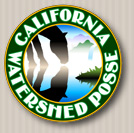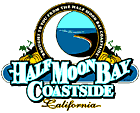

WQPP Watershed Monitoring Studies
Bacteria found in our waterways can cause disease and infection in humans. Recognizing this to be a serious health and safety problem in San Mateo County, the California Watershed Posse aka CWP is recommending a new method to determine if bacteria found in coastal waterways comes from human or non-human sources. This test is a valuable new tool for investigating bacteria contamination of surface waters and for establishing the potential health hazards they present.
Fecal coliform bacteria are common in the digestive tract of both human and other warm-blooded animals. These bacteria may get into the waterways by stormwater runoff, septic tank seepage, discharges from boats or from assorted birds and marine mammals. Since bacteria from ``human waste" may cause illness, it is important to know whether the high bacteria levels seen in county waterways are from people or animals.
CWP recommends a test method to tell the difference between human and non-human fecal bacteria. Scientific literature has explained that cholesterol, a ``lipid" or fat common in the diet of most animals, metabolizes differently in humans than it does in animals. CWP believes analyzing four fecal ``sterols" that are byproducts of the metabolism of colesterol. The fecal sterols being studied are known as coprostanal, epicoprostanol, cholestanol and epicholestanol. Testing labs have developed a method for analyzing these sterols in feces and sediments.
Initial data shows that in fresh fecal samples, the ratio between two of the sterols, coprostanol and cholestanol, may serve as a marker for human fecal bacteria. The work indicates that if the coprostanol concentration ratio is greater than 1.0, it would suggest that the bacteria has a human source. A ratio of less than 1.0 would suggest a mixed or mainly non-human source. The CWP plans to begin field testing of this method and testing is scheduled to begin winter 2000/2001.
Although fecal coliform is common in the feces of all warm-blooded animals, including man, the occurrence of fecal coliform bacteria in the environment is only of concern if it has a human source since many diseases are spread by indirect contact with the feces of an infected person.
What does monitoring of waterway samples for fecal coliform counts show? Primarily they are most useful for watching longterm trends. Single samples results can be misleading because of variables such as rainwater run-off, waterfowl population and tidal influence. Fecal coliform counts do not necessarily indicate the presence of pathogenic organisms (causing human decease) in any sample. Fecal coliform counts only show the total number of bacteria colonies of this type that were present in water at a given time. Additionally, creeks and rivers are dynamic; a single sample result by itself is only valid at the moment it is taken for that particular spot in the river. Because single sample results can be misleading, it is preferable to express the results as the geometric mean of several samples. The geometric mean is the mathematical computation used in the scientific community to make limited statements about the data collected over a period of time.
 |
|
the Half Moon Bay Coastside Foundation's |
|
California Watershed Posse |
|
YOUR MISSION | CRMP SERVICES | CWP PROJECTS | CWP LINKS | THE PEBBLE |
|
1589 Higgins Canyon Road Half Moon Bay, California. 94019 |
|
| |||||||||||||||||||||||||||||||||||||||||||||||||||||




